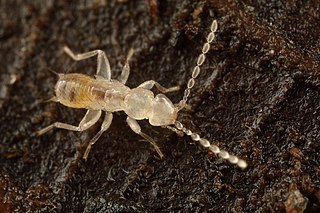
The Tachinidae are a large and variable family of true flies within the insect order Diptera, with more than 8,200 known species and many more to be discovered. Over 1,300 species have been described in North America alone. Insects in this family commonly are called tachinid flies or simply tachinids. As far as is known, they all are protelean parasitoids, or occasionally parasites, of arthropods, usually other insects. The family is known from many habitats in all zoogeographical regions and is especially diverse in South America.

The insect order Zoraptera, commonly known as angel insects, contains small and soft bodied insects with two forms: winged with wings sheddable as in termites, dark and with eyes (compound) and ocelli (simple); or wingless, pale and without eyes or ocelli. They have a characteristic nine-segmented beaded (moniliform) antenna. They have mouthparts adapted for chewing and are mostly found under bark, in dry wood or in leaf litter.

The insect order Neuroptera, or net-winged insects, includes the lacewings, mantidflies, antlions, and their relatives. The order consists of some 6,000 species. Neuroptera is grouped together with the Megaloptera and Raphidioptera (snakeflies) in the unranked taxon Neuropterida.

Hippoboscoidea is a superfamily of the Calyptratae. The flies in this superfamily are blood-feeding obligate parasites of their hosts. Four families are often placed here:

Megaloptera is an order of insects. It contains the alderflies, dobsonflies and fishflies, and there are about 300 known species.

Boris Borisovich Rohdendorf was a Soviet entomologist and curator at the Zoological Museum at the Moscow University. He attained the position of head of the Laboratory of Arthropods, Paleontological Institute, Russian Academy of Sciences, Academy of Sciences of the Soviet Union in Moscow. A student of Andrey Martynov, he was a prolific taxonomist who described numerous new taxa, including fossil Diptera, and published important syntheses on fossil insects. His work was a basis for many Russian paleoentomologists.
Michael S. Engel, FLS, FRES is an American paleontologist and entomologist, notable for contributions to insect evolutionary biology and classification. In connection with his studies he has undertaken field expeditions in Central Asia, Asia Minor, the Levant, Arabia, eastern Africa, the high Arctic, and South and North America, and has published more than 925 papers in scientific journals. Some of Engel's research images were included in exhibitions on the aesthetic value of scientific imagery.

The Empidoidea are a large monophyletic superfamily of true flies, the sister taxon to the Muscomorpha (Cyclorrhapha). These two groups are sometimes united in the unranked taxon Eremoneura. There are some 10,000 known species within Empidoidea, which are represented on all continents except Antarctica. They are known to have existed since the Jurassic period.
Protodiptera is an extinct suborder of mecopteran insects containing the two families Permotanyderidae and Permotipulidae with a total of four genera Choristotanyderus, Permila, Permotanyderus and Permotipula.
The Permotanyderidaea are an extinct family of insects within the order Protodiptera.

Amphiesmenoptera is an insect superorder, established by S. G. Kiriakoff, but often credited to Willi Hennig in his revision of insect taxonomy for two sister orders: Lepidoptera and Trichoptera (caddisflies). In 2017, a third fossil order was added to the group, the Tarachoptera.

The Neuropterida are a clade, sometimes placed at superorder level, of holometabolous insects with over 5,700 described species, containing the orders Neuroptera, Megaloptera, and Raphidioptera (snakeflies).
David A. Grimaldi is an entomologist and Curator of Invertebrate Zoology at the American Museum of Natural History in New York. He received his graduate training at Cornell University, where he earned his doctorate in Entomology in 1986. Dr. Grimaldi is an authority in many fields of insect systematics, paleontology, and evolutionary biology.

Panorpida or Mecopterida is a proposed superorder of Holometabola. The conjectured monophyly of the Panorpida is historically based on morphological evidence, namely the reduction or loss of the ovipositor and several internal characteristics, including a muscle connecting a pleuron and the first axillary sclerite at the base of the wing, various features of the larval maxilla and labium, and basal fusion of CuP and A1 veins in the hind wings. The monophyly of the Panorpida is supported by recent molecular data.

New Jersey Amber, sometimes called Raritan amber, is amber found in the Raritan and Magothy Formations of the Central Atlantic (Eastern) coast of the United States. It is dated to the Late Cretaceous, Turonian age, based on pollen analysis of the host formations. It has been known since the 19th century, with several of the old clay-pit sites now producing many specimens for study. It has yielded a number of organism fossils, including fungi, plants, tardigrades, insects and feathers. The first identified Cretaceous age ant was described from a fossil found in New Jersey in 1966.
Microphorites is an extinct genus of flies in the family Dolichopodidae.

Zhangsolvidae is an extinct family of brachyceran flies known from the Cretaceous period. Members of the family possess a long proboscis, varying in length between 1.3 and 7 mm depending on the species, and were probably nectarivores. A specimen has been found with preserved Bennettitales pollen, suggesting that they acted as pollinators for extinct gymnosperms. They are considered to be members of the Stratiomyomorpha.

Hymenopterida is a superorder of holometabolous (metamorphosing) insects. As originally circumscribed, it included Hymenoptera and the orders in Panorpida. However, more recent studies find Hympenoptera as sister to the other members of Holometabola and the superorder is restricted to Hymenoptera.

Condylognatha or Panhemiptera is a monophyletic grouping (superorder) that contains Hemiptera and Thysanoptera (thrips). Condylognatha belongs to Paraneoptera, which include its sister group, lice (Psocodea).
This paleoentomology list records new fossil insect taxa that were described during the year 2014, as well as notes other significant paleoentomology discoveries and events which occurred during that year.












